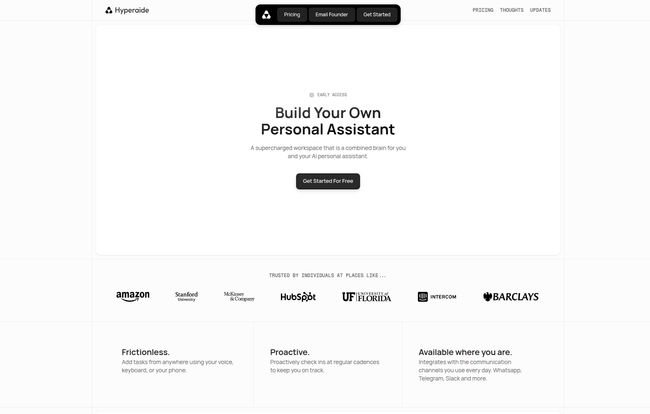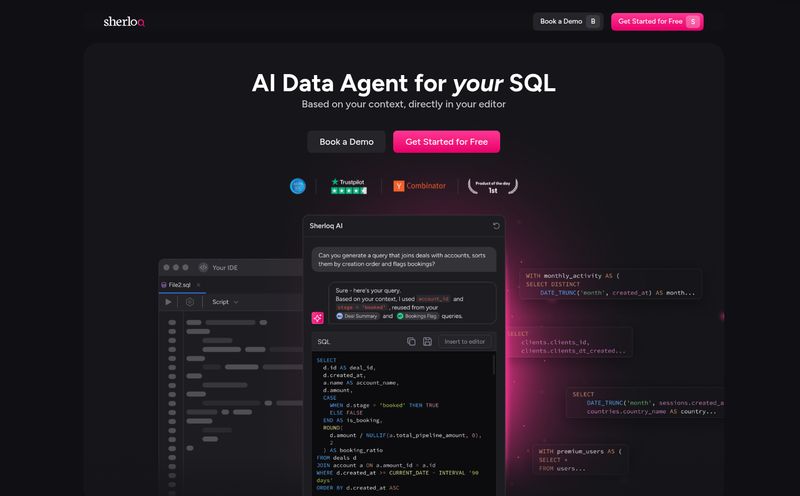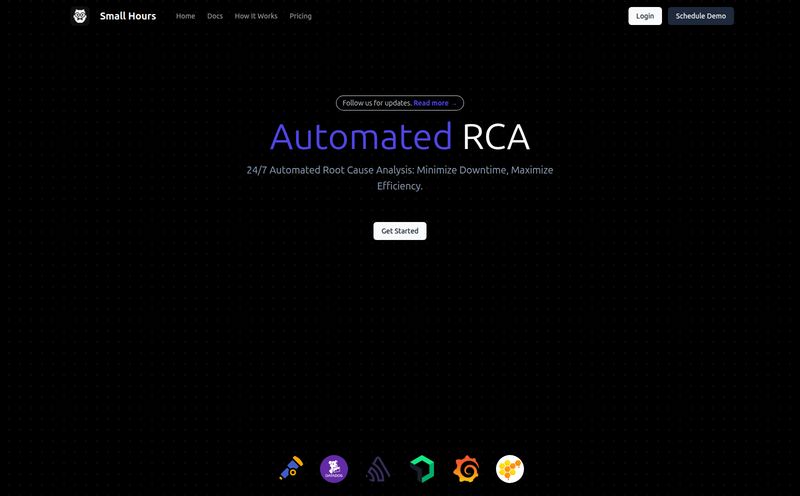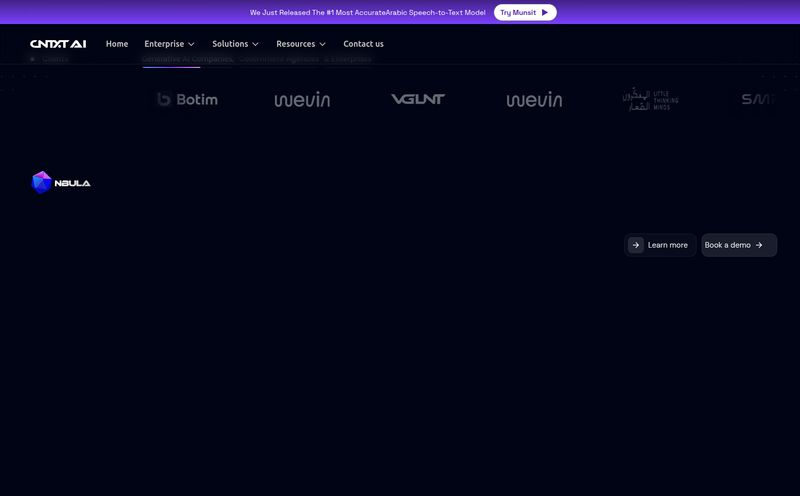If you’ve been building anything with the OpenAI API, you know the feeling. That mix of pure magic when a prompt works perfectly, followed by the head-desking frustration when it doesn’t. Prompt engineering. It's the new wild west, isn't it? One day you have a prompt that sings, the next an API update or a weird user input sends it completely off the rails, and you’re left sifting through endless logs trying to figure out what broke.
I’ve spent more late nights than I care to admit tweaking a single line of text, trying to coax the right response out of GPT-4. It's a messy, chaotic, and often unscientific process. We're essentially whispering instructions into the ear of a super-intelligent but very literal ghost. And until recently, we were doing it with our hands tied behind our backs, hard-coding prompts directly into our apps. A nightmare for updates, a disaster for tracking.
So when a tool like Hyperaide pops up on my radar, claiming to bring some order to this chaos, my ears perk up. It bills itself as a platform to manage, optimize, and look at AI prompts. A control panel for your AI's brain. But is it just another layer of complexity, or is it the tool we’ve all been secretly wishing for? Let's get into it.
So, What Exactly is Hyperaide?
In the simplest terms, Hyperaide acts as a middle-layer between your application and the OpenAI API. Think of it like a mixing board for a sound engineer. Instead of plugging your instruments directly into the main speaker and hoping for the best, you run them through a board where you can tweak the volume, add effects, and control every single input before it ever hits the audience. That's Hyperaide for your AI prompts.
You stop hard-coding prompts into your app. Phew. Instead, your app makes a call to Hyperaide, which then forwards the request to OpenAI with the right, perfectly-tuned prompt you’ve stored in your Hyperaide dashboard. This small shift is a huge deal. It decouples your prompts from your codebase. This means you can update, test, and change prompts without ever needing to redeploy your application. For anyone on a fast-moving team, that’s a game-changer.

Visit Hyperaide
The Core Features That Caught My Eye
A pretty dashboard is nice, but we need substance. I've seen too many slick-looking tools that are all sizzle and no steak. After poking around, a few of Hyperaide's features really stood out as solving actual, painful problems for developers.
Centralized Prompt Management
This is the bread and butter. Having all your prompts in one place, version-controlled, and editable through a UI is the primary win. Your prompts are no longer loose spells you shout into the void; they're organized in a grimoire, ready to be deployed. You can create different configurations for the same task, which is perfect for trying out new ideas without breaking what already works. Its a real organizational blessing.
Performance Analytics That Actually Mean Something
Here’s the thing about prompt optimization: how do you know a new prompt is actually better? Gut feeling? A few manual tests? That doesn’t scale. Hyperaide gives you analytics on your prompt calls. You can track things like response times, token usage, and, most importantly, failure rates. Seeing the data laid out in black and white is the only way to make informed decisions. It's the difference between being a prompt alchemist and a prompt scientist.
Closing the Loop with User Feedback
This might be the most underrated feature. Hyperaide allows you to incorporate user feedback directly into the system. Imagine a user gets a bad response from your AI. They can click a thumbs-down button. That feedback doesn't just go into a black hole; it gets logged against the specific prompt version that was used. Now you have a direct line from user satisfaction back to the exact prompt that needs fixing. That is a huge win for building self-improving AI products.
A/B Testing... Almost
The platform advertises A/B testing, which for me is the holy grail of prompt optimization. The ability to serve two different prompts to users and see which one performs better on a statistical basis? Yes, please. However, it's important to note this feature is listed as "coming soon" and is part of their highest-tier plan. It's a bit of a tease, but the fact that it's on the roadmap shows they're thinking about the right things. I'm excited for this, but also holding my breath.
Let's Talk Turkey: The Pricing Structure
Okay, pricing. Always the awkward-but-necessary conversation. And here, things get a little… interesting. The core pricing, which seems most aligned with their developer-tool focus, is broken into three tiers. I’ve laid it out here because I find tables so much easier to digest.
| Plan | Price | Key Features & Limits |
|---|---|---|
| Free | $0 / forever | Perfect for getting your feet wet. You get 1 user, 1 project, 2 prompts, and 1,000 prompt calls per month. |
| Solo | $25 / month | For the indie hacker or small project. This gives you unlimited projects and prompts with 10,000 calls per month. |
| Team | $100 / month | The full package. 10 users, the much-anticipated A/B testing, and crucial Azure support. Also starts at 10,000 calls/mo. |
The free plan is genuinely useful for trying the platform out. The Solo plan feels about right for a serious project. The Team plan... well, gating Azure support and A/B testing behind the $100 plan is a classic enterprise software move. I get it, but it stings a little for smaller, ambitious teams.
Now, to add a wrinkle, I also saw a separate pricing page on their site (you know me, I click everything) that listed a $20/month personal productivity assistant. This feels like a completely different product, maybe a B2C offering they're testing. It's a bit confusing, but my analysis here is focused on the core developer tool described above.
The Good, The Bad, and The "Coming Soon"
So, should you jump on the Hyperaide train? Like any tool, it’s not perfect. The biggest win, by far, is the shift in mindset it enables. It forces you to treat prompts like a critical part of your infrastructure, not an afterthought. The ability to manage and analyze them centrally will save teams countless hours of guesswork and debugging.
On the flip side, the pricing might be a barrier for some, especially for a tool that sits on top of the cost you're already paying to OpenAI. And the fact that A/B testing isn't here yet is a definite con. It’s like a restaurant advertising the best steak in town but telling you the grill is still being installed. You know it'll be good, but you can't have it right now.
Who is Hyperaide Really For?
After spending some time with it, I have a pretty clear idea of who needs this right now.
- Indie Developers & Startups: If you're building an AI-powered feature, this can be your secret weapon. It lets you iterate and improve your prompts at lightning speed. The Solo plan seems built for this crowd.
- Established Product Teams: If you have multiple developers working on AI features and prompts are scattered across your codebase, you need to stop the madness. This is your intervention. The Team plan will bring much-needed sanity.
- Data-Driven Optimizers: If you're the kind of person who lives in analytics dashboards and believes in testing everything, Hyperaide is speaking your language. Or at least, it will be once A/B testing is live.
This tool is probably not for the casual hobbyist who just pokes at the OpenAI API for fun projects. It’s for people building real products where the quality of the AI response directly impacts user experience and business metrics.
Frequently Asked Questions about Hyperaide
- 1. Do I still need an OpenAI API key to use Hyperaide?
- Yes, absolutely. Hyperaide is a management and optimization layer, not a replacement for the AI model itself. You connect your OpenAI (or Azure OpenAI) key to your Hyperaide account.
- 2. What is the main benefit of Hyperaide over just calling the API directly?
- The main benefits are organization, iteration speed, and data. It separates your prompts from your code, letting you change them without redeploying. The analytics and feedback loops help you make data-driven improvements instead of just guessing.
- 3. Is Hyperaide's free plan enough to get started?
- For sure. The limits of 2 prompts and 1,000 calls are more than enough to integrate Hyperaide into a test project and see if the workflow is right for you. It's a proper free tier, not just a time-limited trial.
- 4. Does Hyperaide work with other AI models besides OpenAI?
- Based on the information available, the focus is squarely on the OpenAI API, with specific support for Azure's OpenAI services in the Team plan. There's no mention of support for other models like those from Anthropic or Google just yet.
- 5. Is the A/B testing feature available now?
- Not quite. It is listed as a feature of the Team plan, but with the note that it is "coming soon". It's on the roadmap, which is a great sign, but not something you can use today.
My Final Verdict
Look, the AI space is moving at a breakneck pace, and the tools to support it are just starting to mature. Hyperaide is a clear sign of that maturation. It addresses a real, tangible pain point that anyone building with LLMs has felt. The prompt is the new code, and it deserves its own management system, its own analytics, its own deployment pipeline.
While I'm tapping my foot waiting for A/B testing to fully arrive, the existing feature set—especially the centralized management and feedback loop—already provides a ton of value. It's a step toward making AI development more systematic, more data-informed, and a whole lot less chaotic. And for that, it definitely gets a nod of approval from me.



